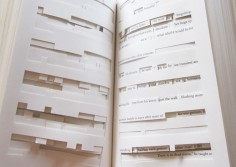

“It’s a way of remembering something about books,” he says. “But it’s not a museum piece.” What is it then? First of all, Tree of Codes is a story-a laconic, poetic narrative about a grieving family-but one that, Foer will be the first to admit, could never work on its own. “You wouldn’t want most books to look like this,” says Foer. But the marvel is that it’s been mass-produced at all. The process was so complicated that to break even, the publisher had to price the paperback at a hardcover-level $40. When I started thinking about Street of Crocodiles”-whose lush, odd turns of phrase offered a near-limitless palette of words-“I started to feel invested in the project.”Īfter months of trial and error, Visual Editions has been able to produce a delicate object resembling a book. “But everything I thought of felt like an exercise. He considered a few options, including an encyclopedia. “I’d thought a lot about die-cutting,” says Foer, referring to the industrial process of punching patterns into material.

Two years ago, a fledgling British publishing outfit called Visual Editions e-mailed Foer with the message “We can’t pay you, but you can make anything.” The company had envisioned something along the lines of graphic renderings of Foer’s novels, but he had a more ambitious idea. The format slows your eye down (though it helps if you slightly lift the page you’re on), but the book is so brief that it can still be read in half an hour. Reading it is a little like going through an FBI document full of blacked-out passages, except that the excised portions are now holes through which you get glimpses of subsequent text.

The result is a new, much shorter story and a paper sculpture, a remarkable piece of inert, unclickable technology: the anti-Kindle. Imagine a book-in this case the 1934 novel The Street of Crocodiles, a surrealistic set of linked stories by the Polish Holocaust victim Bruno Schulz-whose pages have been cut out to form a latticework of words. His latest project, Tree of Codes, may be divisive for a new reason: It’s physically hard to read. They require a leap of faith.” The author’s own first two novels, while hardly avant-garde, do walk a deliberate line between cuteness and horror, taking the reader for a giddy carnival ride, often exhilarating if occasionally nauseating. “Recklessness is what makes experimental art beautiful,” Ashbery wrote, “just as religions are beautiful because of the strong possibility that they are founded on nothing.”įoer, enjoying a hummus wrap a few blocks from his NYU faculty office, says he believes such works have to be either “great or terrible. According to one of Jonathan Safran Foer’s favorite essays, John Ashbery’s 1968 classic “The Invisible Avant-Garde,” what makes innovative work exciting is that you’re never sure it’s any good.


 0 kommentar(er)
0 kommentar(er)
